




By Emma Wozniak Editor-in-Chief
This story has been shortened for this print edition. See the full version at thelantern.com/special-projects/ Taxpayers shelled out at least $3.8 million to help develop a cancertients with chronic lymphocytic leukemia. It now costs over $194,000 per year for those who need it.
rare forms of blood cancer, acalabru-ly, suppressed immune systems that left patients dangerously vulnerable to
established treatments.
This drug’s discovery was a big win for Ohio State researchers, who took the lead role in acalabrutinib’s development and eventual FDA approval. The drug’s high cost, however, has also drawn the attention of a global organization dedicated to making medicalcessible to patients who need them.
Universities Allied for Essential
Medicines, a student-led organization that spans 100 universities across 20their technology licensing agreements with external companies.pany, pharmaceutical or otherwise, to outline plans to make new drugs orers.
Beyond the credit a university receives for aiding in the discovery of a new drug, colleges also receive royalty payments, which are usually a perdrug once it’s on the market.
Although it is unclear how much money Ohio State has made from acalabrutinib, Justin Mendoza, UAEM’s North American executive director, said royalty payments may explain DRUG continues on Pages 2 & 3



why universities have generally “shied away” from the AAP and other similar provisions in the past.
“I think that the fairest way to characterize it is that the goals of a techto commercialize and bring in revenue to the university,” Mendoza said. “And if those are the only two goals that the
or public return on public investment not necessarily like they’re failing at their job, just maybe their job isn’t the correct job.”
Though other university chapters of UAEM have found success in encouraging the adoption of the AAP in their respective technology commercial-
UAEM has run into some roadblocks. In fact, after several meetings with Ohio State’s Technology Commer-
of internal desire” to implement the plan at the university.
Ohio State’s Enterprise for Research, Innovation and Knowledge, of which
work with UAEM student members on
“When you’re trying to use standard language to implement into ev-
translate over very well when you look

at the myriad of things we have coming think with the guidelines, it allows us to just kind of work toward that goal, that common goal, but still allows us to be able to do the things that we need to be able to do in a negotiation process
former president of Ohio State’s UAEM branch, plus an MD candidate in Ohio -
edged the complicated nature of negotiations between universities and companies seeking patents for university-developed technologies. Even so, he said it is important for Ohio State to demonstrate an outward dedication to healthcare accessibility.
“OSU is a huge public institution, and it needs to be a leader in this space,” Chordia said. “That’s how it affects our students, and this is the university that we represent, and the university represents us.”
Breaking down acalabrutinib’s funding and cost
The drug’s research was funded in part by a series of grants from the taxpayer-funded National Institutes of Health, the United States’ main medical research agency. Chordia said funding also came from drug company bought out by fellow biopharmaceutithe drug’s clinical trials, which proved large in both size and cost.
The Lantern concluded via the NIH RePORTER that Ohio State received at least $3,855,328 to research and develop acalabrutinib from the NIH, or in other words, from taxpayers.
According to Drugs.com, the servname for acalabrutinib, is 200 mg one-month supply of 60 tablets costs $16,192, meaning a yearly supply costs $194,305.44.
How Ohio State’s technology licensing works
Notably, both Perkins and Mendoza said neither the TCO nor the researchers involved have any role in determin-

ing the price of Ohio State-developed technologies.
“With those few exceptions where the university actually manufactures the drug, for the most part, universities do not make their own medicines,” Mendoza said. “So, because of that, of course, there’s other costs beyond developing and discovering the drug that are outside the university’s control, and why pharmaceutical companies set the ultimate price.”
Still, Mendoza said universities do “set the rules of the road” by writing -
ability and accessibility before an external company sets a medical technology’s price.
“Ultimately, the university will hold the patent on the original drug, product, whatever it is,” Mendoza said. “And they can determine who is able to use that product and bring it to mar-
Z country or for A, B and C prices.’”
Nick Marchal, current president of UAEM at Ohio State and a third-year in biomedical science, said technologies that make it to this licensing stage tend to have a “higher-earning potential.” This, combined with the fact that pharmaceutical companies usually contribute sums of money to the technology’s development, makes it understandable that such companies would want to earn their money back.
we put in all this research into developing this drug and getting it approved by the FDA; we want to recoup some of our costs,’ which, from a business
standpoint, that’s understandable,” Marchal said. “If you’re investing money, you want to get a return on it. But then, just the way they go about pricing them sometimes is not in the interest of the public, who helps fund them.”
Diving into the AAP
tailored and added to a university’s licensing agreement terms in order toto license, Marchal said.
Though Mendoza said the AAP didn’t exist when acalabrutinib was-
sity of California, Los Angeles’ licensa prime example of why such language would be important going forward.
Rebecca Wolitz, an Ohio State assistant law professor with expertise in bioethics, health law and intellectual property, said she is skeptical of
installed into a university licensing agreement due to uncertainty surrounding whether the plan has “an enforcement provision that has teeth.”
And yet, Wolitz said the symbolism of the language itself is important.
“Regardless of whether or not it actually brings more drugs that are more
think the symbolism of it is as important as an expressive tool for the uniDRUG continued from Page 1


to these sorts of ideals, given our public mission,’” Wolitz said. “So, I think that the expressive and symbolic purpose that these clauses serve shouldn’t be overlooked.”
History of AAP at other universities
After seeing UCLA students protest and petition to get their university to incorporate the AAP into all its new licensing agreements in July 2020, University of California, Berkeley in molecular and cell biology, the former president of Berkeley’s UAEM branch and a current member of the UAEM North American Coordinating Com-
ed to implement the plan at their university.
Eventually, after a few meetings with Berkeley Intellectual Property and Industry Research Alliances, Curtin said the university decided to implement and enforce the AAP in 100% of its intellectual property licenses in April 2023.
Laleh Shayesteh, director of Intellectual Property and Administrationcensing, said implementing the AAP into Berkeley’s licensing agreement was “just one more paragraph to add in.”
“So, when the students came along for this portion to be added into the license agreement, it was not a huge leap for us,” Shayesteh said. “And ever since we put it in, we have negotiated [four it; we have not even had a push back.”
As to why a university may be hesitant to work the AAP into its licensing agreement, Wolitz said one explanation involves the broader assumptions external entities may make. actually might serve more as an expressive or symbolic articulation of a particular worldview that maybe some individuals would be reluctant to include in a kind of agreement, or would think that potential partners would
Shayesteh said it’s too early to know if Berkeley’s relationships with exter-

nal companies in regard to medical technologies will change due to the AAP, but said she thinks “it’s not going to be a big deal,” even 15-16 years down the line when the plan comes to fruition in various agreements.
Though Berkeley is a success story regarding students’ work to implement the AAP, Curtin said the general lack of implementation across the United States for all but two universities demonstrates how challenging such a process can be.
Marchal said although UCLA and Berkeley are the only two universities to have adopted the AAP, 12 others in the United States have indicated willingness to do so, including Columbia University, University of Pennsylvania and University of Michigan.
Shayesteh said she is willing to be a resource for other universities like Ohio State that may be hesitant to include the AAP in their own licensing agreements.
“If there is pushback on the side of Ohio State, they’re welcome to contact me,” Shayesteh said. “I’ve always told this to the students and to UAEM: if somebody wants to talk to me, send them my way. I’m happy to talk to them, I’m happy to describe this to them, if it helps them to put this into their documents and understand why it is that we put it in ours.”
According to email correspondence between Ohio State’s UAEM branch and the university’s Technology Com-
Marchal and Chordia, members of both groups met four times between April 18, 2023, and April 16, 2024.
Though TCO members, such as associate director of licensing in health sciences Panya Taysavang, expressed some preliminary concerns regarding the AAP’s implementation at Ohio State, Chordia said it wasn’t until the
was a “lack of internal desire” to do the to implement AAP into its agreements.
Even so, Perkins said Taysavang and the broader TCO want to maintain their relationship with UAEM studentslines.
with students; we’re committed to creating things that help people and that really impact the world and other willing to speak with them,” Perkins said. “Just based on my conversation waiting on follow-up from students, so if they’re able to connect, I’m sure that process.”
Though Marchal said UAEM at Ohio State students have been working on compiling a list of guidelines since their last meeting with the TCO, he said the guidelines fall short of UAEM’s goals due to its “good faith” implementation, meaning there is no guarantee they will be explicitly included or enforced in licensing agreements.
Perkins said this won’t change the the guidelines.
“I can say, from my experience
guidelines for something, we will certainly do our best to adhere to them, good-faith thing,” Perkins said.
When asked why Ohio State declined to implement the AAP into its licensing language, Shayesteh said even though Berkeley has experienced no pushback since adding the language into its own agreements, Perkins declined to comment.
“I can’t really say, only because I’m just not really familiar with UC Berkeley and how they function, so I don’t want to comment on them,” Perkins said.
add the AAP into its licensing language down the line, Perkins also declined to comment.
“I don’t think I’m in a position to answer that, and then especially because this is still an ongoing thing, I wouldn’t be comfortable forecasting the future in that way,” Perkins said.
Instead, Perkins said again that the distinctness of each individual agreement is what made the TCO believe
best solution going forward, and that
in collaboration with UAEM at Ohio State students.
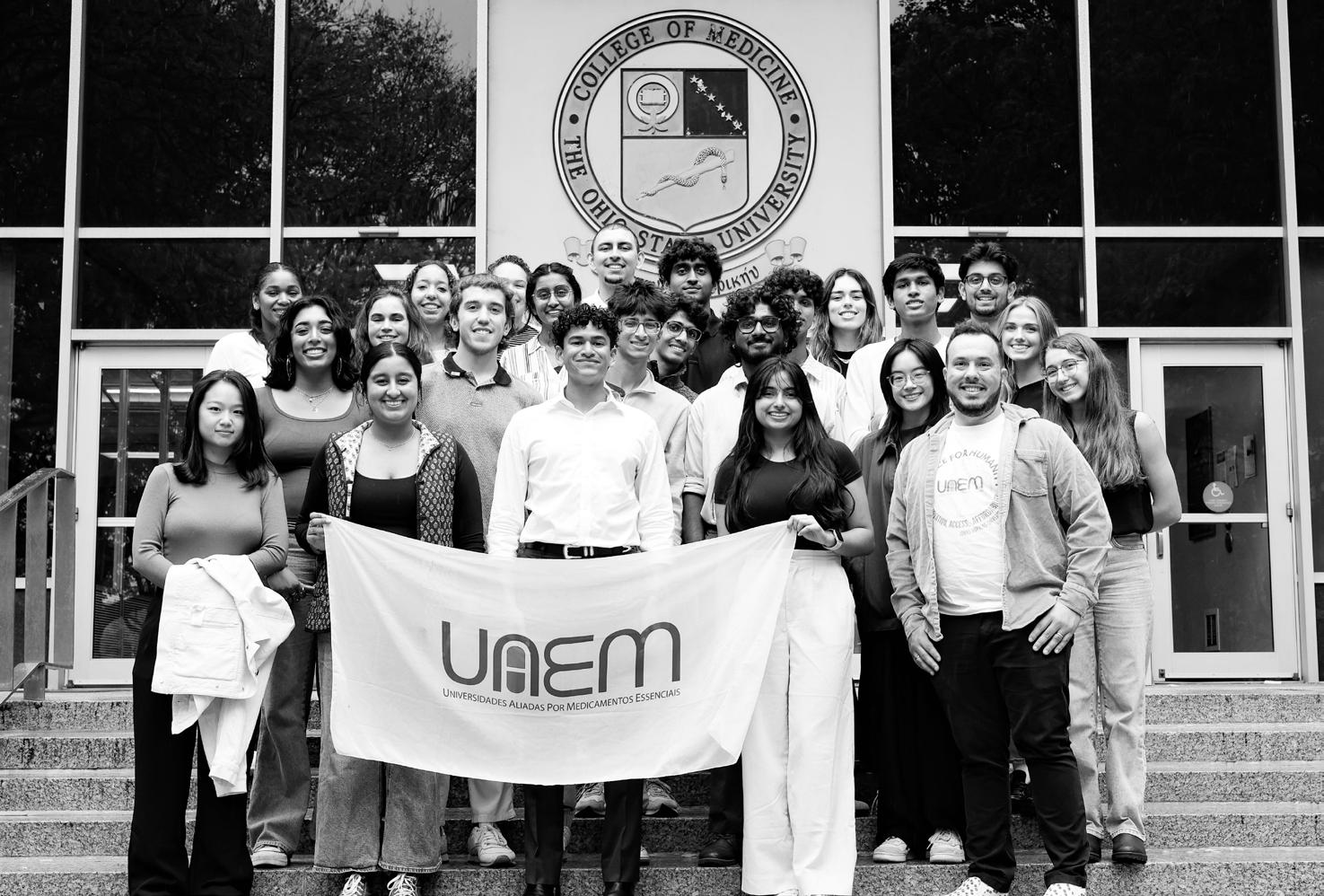
the plan in its licensing agreements.
According to Chordia and Marchal, the TCO expressed April 16 that there
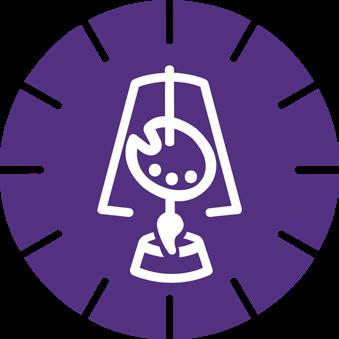
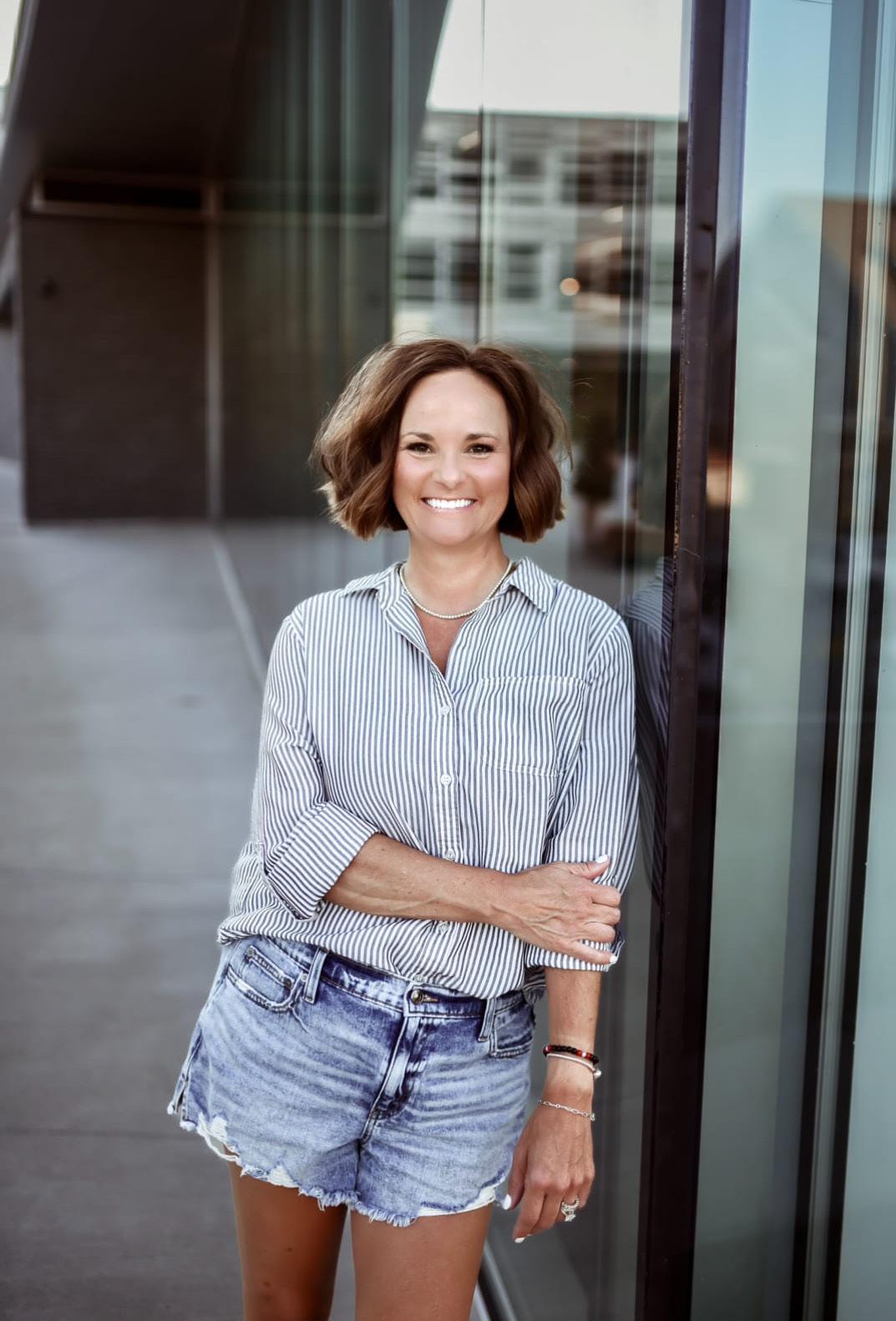
By Lily Shriber Lantern Reporter
Forstudents seeking help with nearly any errand imaginable, just call Joni Mosby.
Mosby, owner of Just Call Joni, a concierge service dedicated to serving Ohio State students, has spent the past two years doing everything from students’ laundry to airport pick-ups and
Mosby said students and parents
number and email on her website and Facebook page. From there, the par-
be involved in order to receive the re -
text with Mosby in order to arrange the
Mosby said she started the business in October 2022 as a way to safely transport Ohio State’s female students to and from the airport and/or doctor’s appointments. She said she noticed a need to provide a safer experience for female students, and thought, “I could just do it myself.”
Since then, Mosby said she has seen
mere 20 clients and now serving nearly 300 students of all genders. She said the business has also expanded to include help from her assistant Michaela McCreavy, along with Ohio State students who help during busier weeks, like move-in and move-out weeks.
-
and last year, we did probably about 130 kids to and from the airport for Thanksgiving,” Mosby said. Mosby said in 2023, she also ex-
support with moving and storage for
she observed within the Ohio State community.
a moving truck, take it, store it for the summer and wherever you move next said.
Mosby said this “see a need, add a service” attitude has stayed with her throughout the past two years, leadinglege student could hope for, including help with laundry, transportation, grocery shopping, custom birthday cakes and gift and food basket deliveries.
really care about their kids and that it’s such a relief to the parents to know that there’s an adult checking on their kid, driving their kid and delivering a special gift to their student,” Mosby said.
Mosby said unlike other delivery and transportation services such as DoorDash and Uber, Just Call Joni provides a more loving and motherly approach. The goal, she said, is to take care of her clients as if they were her own children.
“I got a text very early about a mom that was very distraught about her daughter who had been through a breakup just last night and was up most of the night very upset,” Mosby said. “So, I was able to put together a really nice gift for her and deliver it to her, and the mom got so much peace from that.”
Illana Margolis, mother of a second-year Ohio State student, said Mosby shopped for groceries for her
task that she said brought her so much relief as a worried parent.


“She was always amazing to my daughter and, for a mom, it was nice to have another mom there looking out she was happy to really do anything for us, which has been so nice.”
year Ohio State student, said it is Mosby’s willingness to help, especially in emergency situations, that led her to trust Mosby with her son.
“He’s already had to go to the emergency room twice because of a swollen
on the spot, there in a second.”
Reichbart, an Orlando, Florida, resident, said it is a relief knowing there is someone like Mosby around to help care for her son because she lives so far away from campus.
“She has been a godsend,” Reichbart said. “She is like a second mom.”
Mosby said in recent weeks, she has also been helping students who are voting. She said one particular mother was having trouble helping her daughter send in her mail-in ballot, which -
Mosby said another student realized she didn’t have the correct ID, which led the student’s mother to reach out to Mosby, asking her if she could overnight ship her child’s ID and passport to her and have them brought to her dormitory, to which Mosby said she was happy to help.
“As soon as the FedEx dropped it to campus, and within an hour or two,


Custom-made cupcakes made by Joni Mosby for Ohio State students as a part of Just Call Joni concierge service.
it was in her hands,” Mosby said.
Mosby said as the needs of students continue to expand, so will her services.

“It just continues to grow,” Mosby said. “As I see a need, I just continue to add services and sort of organically let the business grow, and so far so good.”
For more information about Just Call Joni, including arranging a service, visit the business’ website or Facebook page.
e Lantern wants to hear students’ voices
Following former President Donald Trump’s win over Vice President Kamala Harris in the 2024 presidential election, we are seeking out opinions and reactions from Ohio State’s community. Scan this QR code if you want to be featured in a future Lantern story.



By Helena Hennessy Lantern Reporter
Business casual attire and polished resumes will be key componentssign-centered career fair.
Sponsored by the College of Arts and Sciences’ Career Success program, the “Arts, Creative and Design Career Fair” will take place 10 a.m. to 1:30 p.m. Friday at the Ohio Union’s Great Hall, with organizations like Essenceand the Wexner Center for the Arts slated to attend.
sual, written and performing arts, arts management, moving image production, theater, visual communications, Handshake registry.
Though ASC Career Success has sponsored several career fairs in years past, Andrew Freeman, manager for “Arts, Creative and Design Career time the program has helped coordinate an arts-focused career fair.
“It’ll be a standard career fair table fair where students will check in, and then they’ll go into the Great Hall,” Freeman said. “There’ll be employers at tables, and they can walk around, and talk to them, and collect information and network.”
Freeman, assistant director of industry connections for the Center for Career and Professional Success, said this event is something he felt was “needed” at Ohio State.
“We’ll actually have a little bit of much: visual, written, performing, music, etc.,” Freeman said.
Freeman said it’s crucial that students come to the event prepared, particularly with their complete resumes in hand.
Scott Keyes, senior events coordinator at the College of Arts and Sciences, agreed with Freeman. He said

students should plan to arrive early and conversate with as many people as possible.
“Come with a smile on your face and prepareent employers,” Keyes said. “Say something to everybody because you never know what composition those particular employers may have of interest.”
Freeman said it is crucial to take advantage of career fair opportunities, even if they may seem nerve-racking at
“I know it can be really intimidating, walking into a big room full of people you don’t know, but that’s just something you have to do and it gets easier the more you do it,” Freeman said.
Keyes said these fairs help foster valuable connections between students and various employers, which can possibly lead them to future jobs and career paths.
“Get cards, get information, get LinkedIn information and build those relationships with those employers,” Keyes said. “Over the course of time, just become available, and because you kept in contact with that employer, got this opportunity.’”
Freeman also said attending the fair can assist students in discovering not be currently pursuing.
music might think of something else they want to do besides performance or in addition to performing,” Freeman said. “Maybe they want to teach art as well as make art.”
Freeman said most of all, he hopes students learn more about networkingreer fair.
“Practice career development skills, like working on your resume and networking; interviewing too, because it’s kind of like a mini interview,” Freeman said. “Those are things that our department can help students with too. Use it as a learning opportunity because you’re going to be doing these types of events for the rest of your life.”
Freeman said students can register to attend the career fair online via Handshake or simply show up to the event with a valid BuckID.
More information about the event, including the registration link, can be found on Ohio State’s website.






FIELD HOCKEY

By Thomas Beebe Lantern Reporter
The Buckeyes are set to travel to College Park, Maryland, for their Big Ten Tournament opener.
against Central Michigan, the No. 7 Buckeyes (14-4, 4-4 Big Ten) are looking to continue their strong play on the road against the Rutgers Scarlet Knights (7-8, 4-4 Big Ten) to open the Big Ten Tournament Thursday.
The last time these two teams met, Rutgers came away victorious with a 1-0 win over Ohio State in Piscataway, New Jersey Oct. 20.
Despite the desire to get even with the Scarlet Knights, Buckeyes midteam’s drive isn’t just about revenge, but also about playing the game to the best of its ability.
“I think it’s almost a mix of both because, yes, we’re
hungry
for it, we
know we can do it,
but we also have to keep playing our game and play Ohio
way we know how to,” Krebs said.
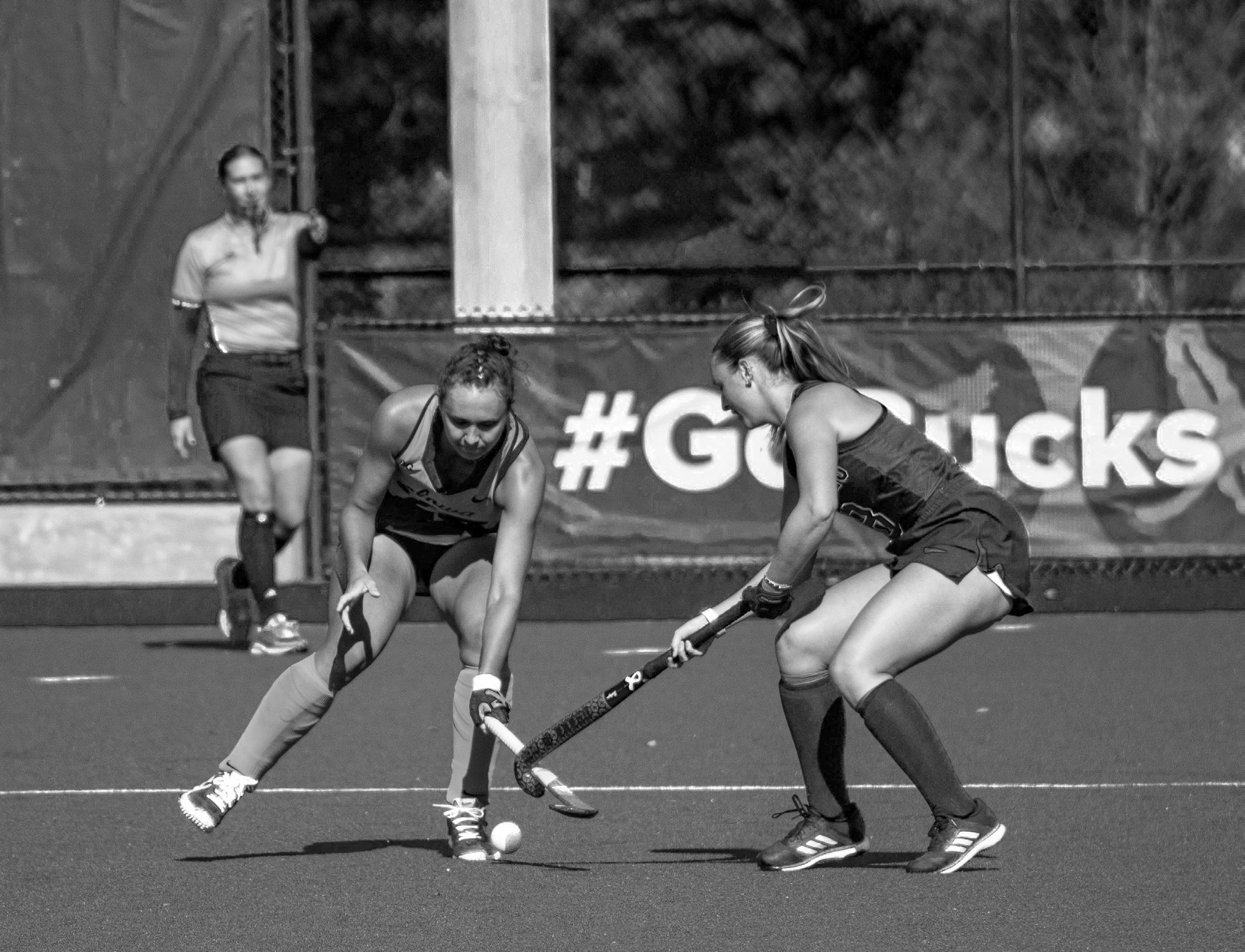
the No. 16 Hawkeyes.
believes this time around, the Buckwith their speed along the perimeter.
a little bit just to try out new people at advantages,” Krebs said. “I think we’re going to be really successful when we’re able to shift their defense and really attack hard up the sides.”
Head coach Jarred Martin said he knows his team’s speed will be vital in taking down Rutgers. He also put emphasis on how the Buckeyes have seen this team before and the adjustments
that have consequently been made.
“This is truly going to be a test of who’s making adjustments and who’s executing those adjustments,” Martin said. “The game will favor the team that’s taking it to the other person and competing the whole time. These games and the teams involved are so close in our conference that if you back probably going to strike.”
Despite all the game-planning and preparation the Buckeyes have done ahead of the Big Ten Tournament, Krebs said she credits her fellow play-
ers’ trust in each other as the most important factor in helping them compete.
“It’s one of our core values. It’s something that if your team doesn’t have, it can’t be successful,” Krebs said. “I need to trust that my defense
we do turn it over, that they’ll be back there, protecting the goal for us.”
The Buckeyes and Scarlet Knights
Park, Maryland. The broadcast will be available on Big Ten Plus.

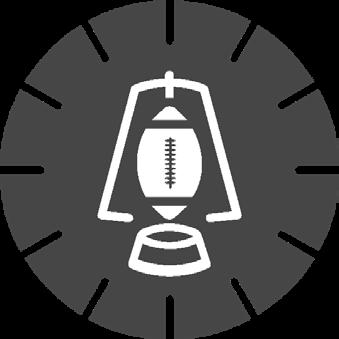
match against Rutgers
By Sam Cipriani Asst. Sports Editor
After surviving one of its toughest challenges of the season, Ohio State now faces a team still seeking its
In a contest between two teams ex-
No. 2 Buckeyes (7-1, 4-1 Big Ten) are set to play the Purdue Boilermakers (1-7, 0-5 Big Ten) Saturday at noon at Ohio Stadium.
Since Purdue’s 49-0 blowout victory over Indiana State in week one, the Boilermakers haven’t claimed a single win.
Purdue has fallen twice in overtime this season, with a 50-49 game against Illinois Oct. 12 and a 20-14 loss Saturday against Northwestern.
According to FanDuel Sportsbook, the spread for Ohio State’s game against the Boilermakers is favoring the Buckeyes by 37.5 points, meaning Ohio State must win by at least 38 points for bettors to cover and win their wager.
Despite experts’ and Vegas predictions, Buckeyes head coach Ryan Day said his players must keep their heads on their shoulders and avoid underestimating the Boilermakers due to their record.
“I think, you know, they’re a much better team than their record shows, so we got to have a great week of practice and keep growing,” Day said.
“If anybody in this building here is thinking about last week, then they’re distracted and that can’t happen.”
The Boilermakers are led by quarterback Hudson Card, who has amassed 1,005 yards and eight touchdowns, while throwing four interceptions this season. Backup quarterback Ryan Browne has also received considerable time, racking up 473 yards and three touchdowns.
Running back Devin Mockobee tops the Boilermaker skill position players with 671 total yards, as well as four total touchdowns — three on the ground and one through the air.
On the other side, the Buckeyes’ rushing attack features the duo Quinshon Judkins and TreVeyon Henderson. The pair has rushed for 1,001 yards and 10 touchdowns this season, fueling the Ohio State
Ohio State also boasts a commanding defense that’s ranked No. 2 in the country in yards, only having allowed 256.4 yards per game, and No. 3 in points allowed per game with just 12, according to the NCAA’s website.
With a win over the Nittany Lions, Ohio State now controls its own destiny on the way to a possible trip to Indianapolis for the Big Ten Championship.

With their victory in Happy Valley, the Buckeyes hope to continue their momentum into their home game against Purdue and throughout the rest of the season, Day said.
“We got to continue to build on what happened last week, and that’s what today’s going to be all about in Tuesday practice,” Day said.
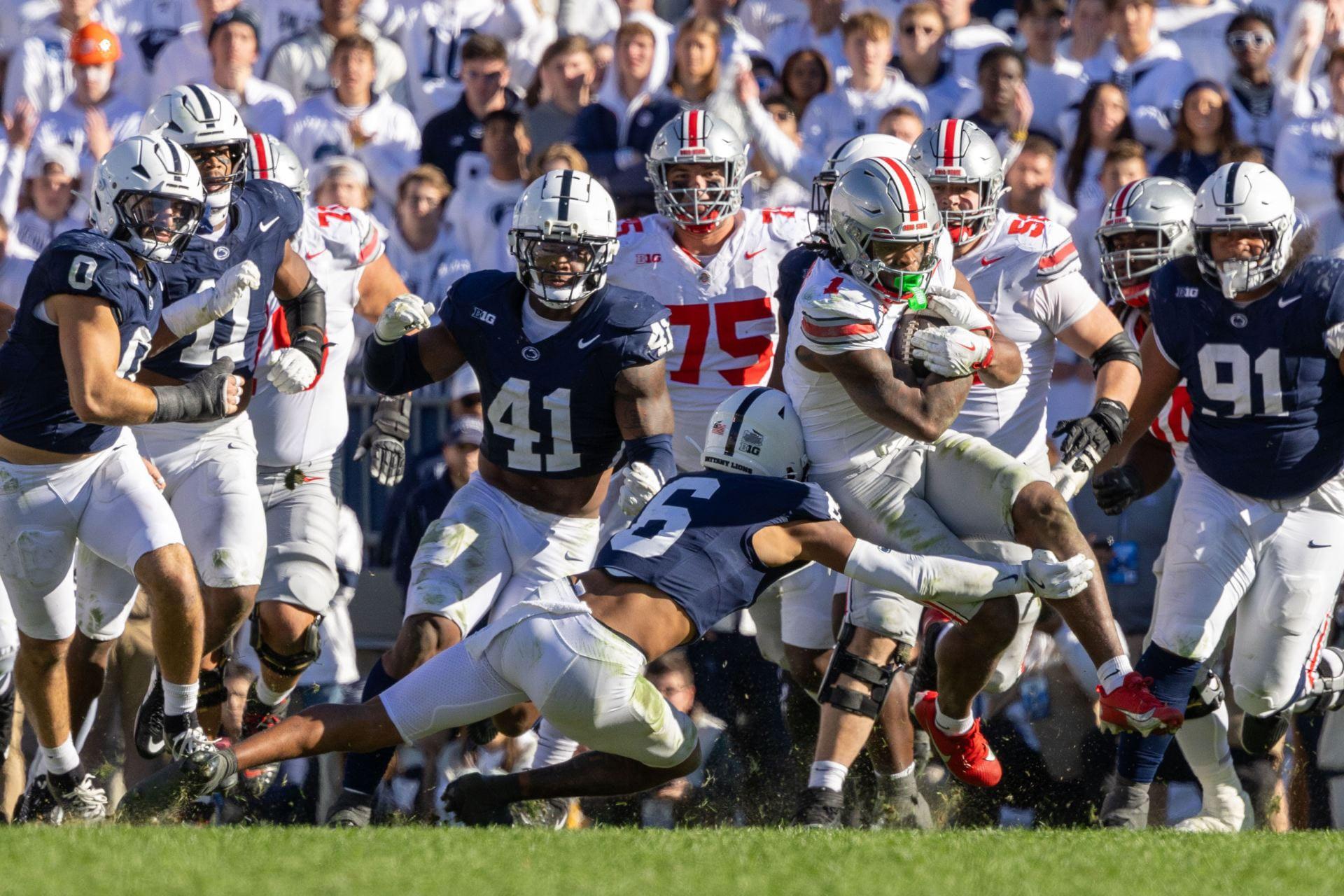
and two catches for a team-leading 100 yards.
BOTTOM: Head coach
Day watches the Buckeyes warm up prior to their 20-13 victory against Penn State Saturday at Beaver Stadium.



